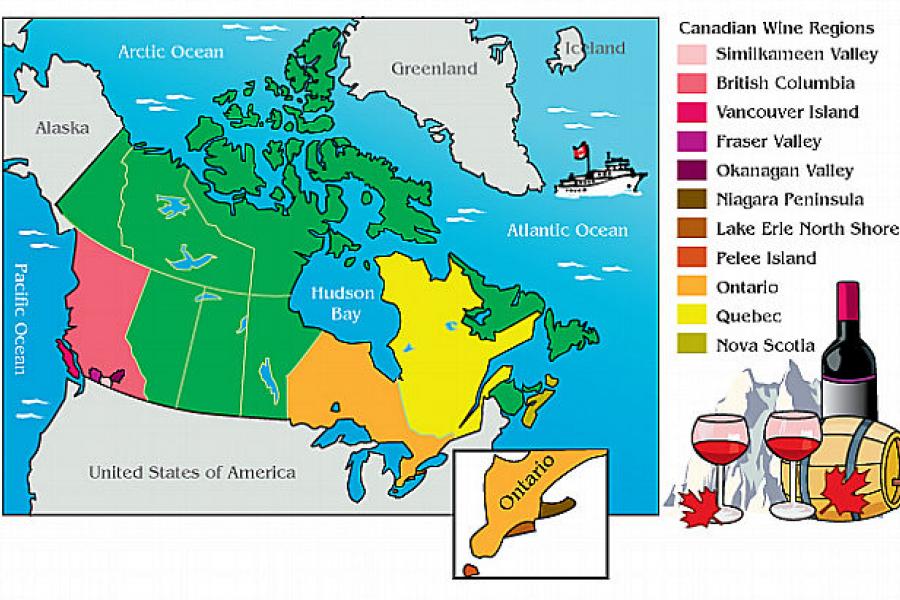Wine in Canada
Many are not aware that Canada also produces wine.
Climate is a challenge and most of the territory is not suitable, nevertheless, Canada is producing some world class wines.
Wine regions in Canada
Most of Canada's winemaking is associated with British Columbia, and justly so. In the last 20 years the wines of British Columbia have become world-class competitors. But wine is almost made in all of Canada's provinces, often under much more difficult conditions. And many of these small family businesses are beginning to produce award winning vintages.
Canada extends 4,875 miles (7,800 km) from the Pacific to the Atlantic Ocean, from Newfoundland to Vancouver Island off the west coast of British Columbia.
But despite the country's reputation for northern latitudes and cold winters, some parts actually lie further south than the famous Burgundy region of France. The Ontario region, for example lies between the 41st and 52nd latitudes, putting them at the parallel as Bordeaux, France and California's Napa Valley.
The enormous land mass, oceans and numerous fresh water lakes and tall mountains give Canada a wide variety of micro-climates that the growers take good advantage of in producing wine grapes. Most grown are some variety of vinifera, long thought not to thrive so far north. Thanks to old traditions combined with modern science, they do well even in Quebec.
One of the newest wineries is the Bosc family's Chateau des Charmes, founded in 1978 in the Niagara Peninsula where the temperate climate provides up to 190 frost free growing days per year.
Ideally located on the south of Lake Ontario at 44 degrees latitude, this enormous Chateau is headquarters to vineyards that produce an excellent Chardonnay, barrel fermented and aged in French oak barrels. The result is a full-bodied buttery wine with flavors of tropical fruit and melon that pairs well with poultry or pasta.
The Cabernet Sauvignon is another favorite with a deep ruby color and the bouquet of cassis and bell pepper. Full-bodied and an excellent match for prime rib, it can age for 5-10 years.
Elsewhere in Niagara is Coyote's Run which opened its doors in May, 2004. In heavy limestone clay and taking advantage of the warm breezes off the water, the 3C (5.4F) higher average temperature here allows the harvest to occur 1-2 weeks earlier than most other vineyards in the area.
The dark brown clay common to the area produces a grape distinctly different from that of the more fruity and perfumed from the red clay. Look for this small entrepreneur to grow in the coming years.
Even Montreal is home to some of Quebec's wineries, located on the western section of the glacial plain. Here a medium-body red is produced from a blend of Cabernet Severnyi, Frontenac and Landot. Full of ripe black fruit flavors with hints of oak, licorice and vanilla, it is aged in American oak.
Not to be ignored, tiny Prince Edward Island even gets into the act where the harsh climate requires that some grape varieties be grown only in greenhouses. Seyval Blanc, Marechal, Ortega and others produce a nicely acid balanced Rossignol wine.
Nova Scotia too hosts 22 grape growers where French hybrids Maréchal Foch, Baco Noir, and DeChaunac are grown, though icewine remains the specialty.
There are many others: Alberta. Sunshine ranges from 1,900 hours in the north to 2,300 hours in the south where the Rockies produce warm, dry Chinook winds. One Chinook raised the temperature from -2.2°F (-19°C) to 38°F (3.3°C)in a single hour. Saskatchewan in the heart of North America, bordered on the south by Montana and North Dakota. Manitoba, once a flood plain, now seeing cold winters and sunny summers averaging 25C (77F).
All these and more give evidence of Canada's unquenchable desire to grow the winemaking business into one which will rightfully take its place on the world stage.
Canadian ice wine is something to try. Ice wine is a delicious dessert wine made from frozen grapes. Sugars are concentrated and the wine is sweet, but not overly so.

